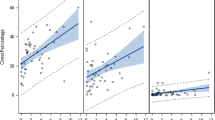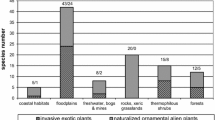Abstract
Biological invasion is probably one of the most serious threats to biodiversity after climate change. Landscape distinguished by the heterogeneity of structure, forms, human interferences, and environmental settings plays an important role in the establishment and spread of invasive species. We investigated the effect of the spatial heterogeneity for a selected landscape upon the invasion process through a case study of Hyptis (Hyptis suaveolens) in the Indian Western Himalayan region. The selected study site constitutes a heterogeneous landscape of 32,300 ha in the state of Uttarakhand, placed at the lower elevation of the Indian Himalaya. The landscape has varying levels and patterns of Hyptis invasion. We quantified the spatial heterogeneity in terms of elevation; distance from the canal, river, road, and settlement; and 18 landscape metrics (at the patch and land use class level) to investigate their influence on the invasion; for this purpose, a logistic regression model was developed. The invasion of Hyptis was found to be governed by spatial heterogeneity. The highest probability of invasion was found in the areas adjacent to rivers and roads. The analysis at patch level revealed that the invasion is largely governed by the perimeter-area ratio of patches and is positively correlated. This suggests for greater invasion chances in smaller patches as compared with larger ones. The analysis for the land use class metrics indicated a higher influence of edge density expressed as total edge length of patches per unit area, followed by patch density expresses as a total number of patches per unit area. Hence, the landscapes with larger edges and more number of patches are supposed to be more prone to invasion risks. The results of the study can be used by forest managers in designing a landscape-level system to control invasion.







Similar content being viewed by others
References
Adhikari, D., Tiwary, R., & Barik, S. K. (2015). Modelling hotspots for invasive alien plants in India. PloS one, 10(7), e0134665.
Alpert, P., Bone, E., & Holzapfel, C. (2000). Invasiveness, invasibility and the role of environmental stress in the spread of non-native plants. Perspectives in plant ecology, evolution and systematics, 3(1), 52–66.
Champion, H. G., & Seth, S. K. (1968). A Revised Survey of the Forest Types of India. New Delhi: Government of India Publication.
Clark, W. A. V., & Hosking, P. L. (1986). Statistical methods for geographers. New York: Wiley.
Deacon, A. E., Ramnarine, I. W., & Magurran, A. E. (2011). How reproductive ecology contributes to the spread of a globally invasive fish. PLoS One, 6(9), e24416.
Decocq, G. (2010). Invisibility promotes invasibility. Frontiers in Ecology and the Environment, 8(7), 346–347.
Driscoll, D. A., Banks, S. C., Barton, P. S., Lindenmayer, D. B., & Smith, A. L. (2013). Conceptual domain of the matrix in fragmented landscapes. Trends in ecology & evolution, 28(10), 605–613.
Elith, J., Phillips, S. J., Hastie, T., Dudík, M., Chee, Y. E., & Yates, C. J. (2011). A statistical explanation of MaxEnt for ecologists. Diversity and distributions, 17(1), 43–57.
Forman, R. T. T., & Godron, M. (1986). Landscape ecology John Wiley & Sons. New York, 4, 22–28.
Hansen, M. J., & Clevenger, A. P. (2005). The influence of disturbance and habitat on the presence of non-native plant species along transport corridors. Biological conservation, 125(2), 249–259.
Hellmann, J. J., Byers, J. E., Bierwagen, B. G., & Dukes, J. S. (2008). Five potential consequences of climate change for invasive species. Conservation biology, 22(3), 534–543.
Heshner, D., & Johnson, L. W. (1981). Applied discrete choice modeling. London: Croom Helm.
Jesus, N. Z. T., Falcão, H. S., Lima, G. R. M., Caldas Filho, M. R. D., Sales, I. R. P., Gomes, I. F., Santos, S. G., Tavares, J. F., Barbosa-Filho, J. M., & Batista, L. M. (2013). Hyptis suaveolens (L.) Poit (Lamiaceae), a medicinal plant protects the stomach against several gastric ulcer models. Journal of ethnopharmacology, 150(3), 982–988.
Khaiter, P. A., & Erechtchoukova, M. G. (2017). Conceptual design of a software tool for management of biological invasion. In Environmental Software Systems. Computer Science for Environmental Protection: 12th IFIP WG 5.11 International Symposium, ISESS 2017, Zadar, Croatia, May 10-12, 2017, Proceedings 12 (pp. 209–220). Springer.
Khuroo, A. A., Reshi, Z. A., Malik, A. H., Weber, E., Rashid, I., & Dar, G. H. (2012). Alien flora of India: taxonomic composition, invasion status and biogeographic affiliations. Biological Invasions, 14(1), 99–113.
Khuroo, A. A., Reshi, Z., Rashid, I., Dar, G. H., & Malik, A. H. (2009). Plant invasions in montane ecosystems. Frontiers in Ecology and the Environment, 7(8), 408.
Kie, J. G., Bowyer, R. T., Nicholson, M. C., Boroski, B. B., & Loft, E. R. (2002). Landscape heterogeneity at differing scales: effects on spatial distribution of mule deer. Ecology, 83(2), 530–544.
Kumar, S., Simonson, S. E., & Stohlgren, T. J. (2009). Effects of spatial heterogeneity on butterfly species richness in Rocky Mountain National Park, CO, USA. Biodiversity and Conservation, 18(3), 739–763.
Kumar, S., & Stohlgren, T. J. (2009). Maxent modeling for predicting suitable habitat for threatened and endangered tree Canacomyrica monticola in New Caledonia. Journal of Ecology and the Natural Environment, 1(4), 94–98.
Kumar, S., Stohlgren, T. J., & Chong, G. W. (2006). Spatial heterogeneity influences native and nonnative plant species richness. Ecology, 87(12), 3186–3199.
Levins, R. (1968). Evolution in changing environments: some theoretical explorations. Princeton University Press.
Li, H., & Reynolds, J. F. (1994). A simulation experiment to quantify spatial heterogeneity in categorical maps. Ecology, 75(8), 2446–2455.
Lustig, A., Stouffer, D. B., Doscher, C., & Worner, S. P. (2017). Landscape metrics as a framework to measure the effect of landscape structure on the spread of invasive insect species. Landscape Ecology, 32(12), 2311–2325. https://doi.org/10.1007/s10980-017-0570-3.
Mazza, G., Tricarico, E., Genovesi, P., & Gherardi, F. (2014). Biological invaders are threats to human health: an overview. Ethology Ecology & Evolution, 26(2–3), 112–129.
McGarigal, K., Cushman, S. A., & Ene, E. (2012). FRAGSTATS v4: spatial pattern analysis program for categorical and continuous maps. Computer software program produced by the authors at the University of Massachusetts, Amherst. http://www. umass. edu/landeco/research/fragstats/fragstats. html.
Meyer, J. S., Irwin, L. L., & Boyce, M. S. (1998). Influence of habitat abundance and fragmentation on northern spotted owls in western Oregon. Wildlife Monographs, 3–51.
Minor, E. S., Tessel, S. M., Engelhardt, K. A. M., & Lookingbill, T. R. (2009). The role of landscape connectivity in assembling exotic plant communities: a network analysis. Ecology, 90(7), 1802–1809.
Mondal, K. C., Dey, S., & Pati, B. R. (2007). Antimicrobial activity of the leaf extracts of Hyptis suaveolens (L.) poit. Indian Journal of Pharmaceutical Sciences, 69(4), 568.
Nunn, A. D., Bolland, J. D., Harvey, J. P., & Cowx, I. G. (2007). Establishment of self-sustaining populations of non-native fish species in the River Trent and Warwickshire Avon, UK, indicated by the presence of 0+ fish. Aquatic Invasions, 2, 190–196. https://doi.org/10.3391/ai.2007.2.3.6.
Padalia, H., Kudrat, M., & Sharma, K. P. (2013). Mapping sub-pixel occurrence of an alien invasive Hyptis suaveolens (L.) Poit. using spectral unmixing technique. International journal of remote sensing, 34(1), 325–340.
Padalia, H., Srivastava, V., & Kushwaha, S. P. S. (2014). Modeling potential invasion range of alien invasive species, Hyptis suaveolens (L.) Poit. in India: Comparison of MaxEnt and GARP. Ecological informatics, 22, 36–43.
Pearson, R. G. (2007). Species’ distribution modeling for conservation educators and practitioners. Synthesis. American Museum of Natural History, 50.
Phillips, S. J., Dudík, M., & Schapire, R. E. (2004). A maximum entropy approach to species distribution modeling. Proceedings of the Twenty-first international conference on Machine learning - ICML ’04, 655–662.
Raizada, P. (2006). Ecological and vegetative characteristics of a potent invader, Hyptis suaveolens Poit. from India. Lyonia, 11(2), 115–120.
Rangel, T. F., Diniz-Filho, J. A. F., & Bini, L. M. (2010). SAM: a comprehensive application for spatial analysis in macroecology. Ecography, 33(1), 46–50.
Razanajatovo, M., Maurel, N., Dawson, W., Essl, F., Kreft, H., Pergl, J., Pyšek, P., Weigelt, P., Winter, M., & van Kleunen, M. (2016). ARTICLE Plants capable of selfing are more likely to become naturalized. Nature Communications, 7. https://doi.org/10.1038/ncomms13313.
Rejmánek, M., & Richardson, D. M. (1996). What attributes make some plant species more invasive? Ecology, 77(6), 1655–1661.
Richardson, D. M., Pyšek, P., Rejmánek, M., Barbour, M. G., Panetta, F. D., & West, C. J. (2000). Naturalization and invasion of alien plants: concepts and definitions. Diversity and distributions, 6(2), 93–107.
Smith, P. A. (1994). Autocorrelation in logistic regression modelling of species’ distributions. Global ecology and biogeography letters, 4, 47–61.
Stockwell, D. (1999). The GARP modelling system: problems and solutions to automated spatial prediction. International journal of geographical information science, 13(2), 143–158.
Stohlgren, T. J., Bull, K. A., Otsuki, Y., Villa, C. A., & Lee, M. (1998). Riparian zones as havens for exotic plant species in the central grasslands. Plant Ecology, 138(1), 113–125.
Szymura, M., Szymura, T. H., & Świerszcz, S. (2016). Do Landscape Structure and Socio-Economic Variables Explain the Solidago Invasion? Folia Geobotanica, 51(1), 13–25. https://doi.org/10.1007/s12224-016-9241-4.
Turner, M. G. (2005). Landscape ecology: what is the state of the science? Annual Review of Ecology, Evolution, and Systematics, 36, 319–344.
Venkateshappa, S. M., & Sreenath, K. P. (2013). Potential medicinal plants of Lamiaceae. American International Journal of Research in Formal, Applied and Natural Sciences, 1(3), 82–87.
Vilà, M., Espinar, J. L., Hejda, M., Hulme, P. E., Jarošík, V., Maron, J. L., Pergl, J., Schaffner, U., Sun, Y., & Pyšek, P. (2011). Ecological impacts of invasive alien plants: a meta-analysis of their effects on species, communities and ecosystems. Ecology letters, 14(7), 702–708.
Willis, J. C. (1973). A dictionary of the flowering plants and ferns. CUP Archive.
Wilson, E. O., & MacArthur, R. H. (1967). The theory of island biogeography. Princeton, NJ.
Yang, X.-Q., Kushwaha, S. P. S., Saran, S., Xu, J., & Roy, P. S. (2013). Maxent modeling for predicting the potential distribution of medicinal plant, Justicia adhatoda L. in Lesser Himalayan foothills. Ecological engineering, 51, 83–87.
Acknowledgments
The authors would like to thank the Indian Institute of Remote Sensing (IIRS), Dehradun, for providing computational and logistic support during the field survey. The study was also supported by the Indian Council of Forestry Research and Education (ICFRE), Dehradun which is gratefully acknowledged. Anonymous reviewers are acknowledged for their valuable comments.
Author information
Authors and Affiliations
Corresponding author
Additional information
Publisher’s note
Springer Nature remains neutral with regard to jurisdictional claims in published maps and institutional affiliations.
This article is part of the Topical Collection on Terrestrial and Ocean Dynamics: India Perspective
Rights and permissions
About this article
Cite this article
Kumar, M., Padalia, H., Nandy, S. et al. Does spatial heterogeneity of landscape explain the process of plant invasion? A case study of Hyptis suaveolens from Indian Western Himalaya. Environ Monit Assess 191 (Suppl 3), 794 (2019). https://doi.org/10.1007/s10661-019-7682-y
Received:
Accepted:
Published:
DOI: https://doi.org/10.1007/s10661-019-7682-y




